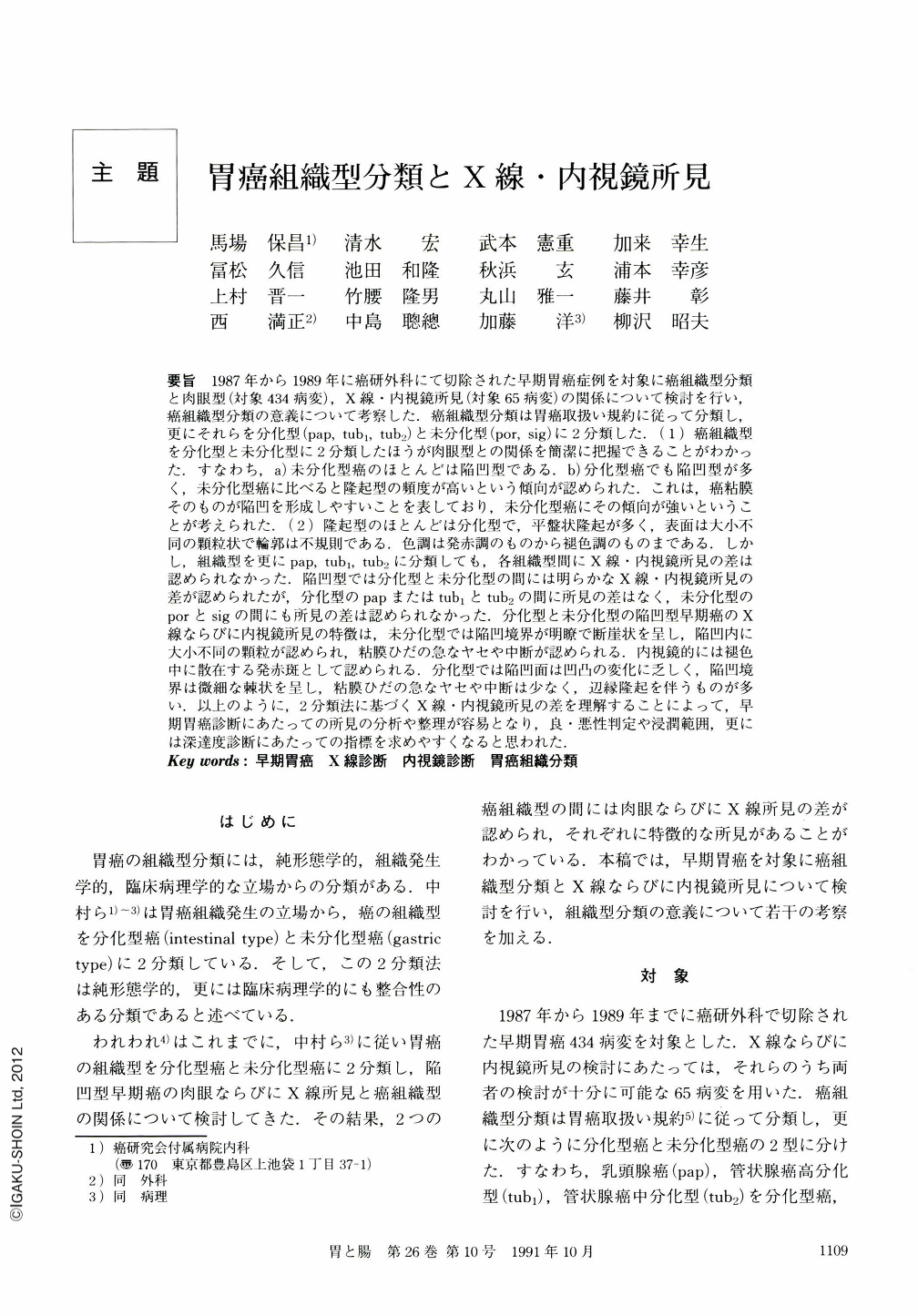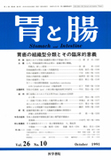Japanese
English
- 有料閲覧
- Abstract 文献概要
- 1ページ目 Look Inside
- サイト内被引用 Cited by
要旨 1987年から1989年に癌研外科にて切除された早期胃癌症例を対象に癌組織型分類と肉眼型(対象434病変),X線・内視鏡所見(対象65病変)の関係について検討を行い,癌組織型分類の意義について考察した.癌組織型分類は胃癌取扱い規約に従って分類し,更にそれらを分化型(pap,tub1,tub2)と未分化型(por,sig)に2分類した.(1) 癌組織型を分化型と未分化型に2分類したほうが肉眼型との関係を簡潔に把握できることがわかった.すなわち,a)未分化型癌のほとんどは陥凹型である.b)分化型癌でも陥凹型が多く,未分化型癌に比べると隆起型の頻度が高いという傾向が認められた.これは,癌粘膜そのものが陥凹を形成しやすいことを表しており,未分化型癌にその傾向が強いということが考えられた.(2) 隆起型のほとんどは分化型で,平盤状隆起が多く,表面は大小不同の顆粒状で輪郭は不規則である.色調は発赤調のものから褪色調のものまである.しかし,組織型を更にpap,tub1,tub2に分類しても,各組織型間にX線・内視鏡所見の差は認められなかった.陥凹型では分化型と未分化型の間には明らかなX線・内視鏡所見の差が認められたが,分化型のpapまたはtub1とtub2の間に所見の差はなく,未分化型のporとsigの間にも所見の差は認められなかった.分化型と未分化型の陥凹型早期癌のX線ならびに内視鏡所見の特徴は,未分化型では陥凹境界が明瞭で断崖状を呈し,陥凹内に大小不同の顆粒が認められ,粘膜ひだの急なヤセや中断が認められる.内視鏡的には褪色中に散在する発赤斑として認められる.分化型では陥凹面は凹凸の変化に乏しく,陥凹境界は微細な棘状を呈し,粘膜ひだの急なヤセや中断は少なく,辺縁隆起を伴うものが多い.以上のように,2分類法に基づくX線・内視鏡所見の差を理解することによって,早期胃癌診断にあたっての所見の分析や整理が容易となり,良・悪性判定や浸潤範囲,更には深達度診断にあたっての指標を求めやすくなると思われた.
In order to elucidate the clinical meaning of histlogical classification of gastric cancer, study was conducted on its relationship with macroscopic type (434 lesions) and radiological and endoscopic findings (65 lesions) in early cancers resected at Surgical Department, Cancer Institute Hospital, from 1987 to 1989. Histological classification was based on The General Rule for the Gastric Cancer Study in Surgery and Pathology, and dichotomous division into well differentiated type (pap, tub1, tub2) and poorly differentiated type (por, sig).
(1) Dichotomous division into well differentiated cancers and poorly differentiated cancers was more useful in clearly showing the relationship between histological classification and macroscopic type. That is, (a) most of the poorly differentiated cancers were depressed type, and (b) although depressed type occupied the majority of well differentiated cancers, elevated type occurred more frequently than in poorly differentiated cancers. It is speculated that cancer mucosa tends to be depressed and that this tendency is stronger for poorly differentiated cancers.
(2) Most of the elevated type lesions were well differentiated cancers, mostly flat elevated, covered by granular surface of varying sizes, and with irregular demarcation. Color ranged from red tinge to brown tinge. Further histological classification into pap, tub1, and tub2, however, failed to show any difference in radiological and endoscopic findings among these histological types. While there were obvious differences in radiological and endoscopic findings between well differentiated and poorly differentiated cancers of depressed type, there were no such differences among pap, tub1, and tub2 of well differentiated cancers, and between por and sig of poorly differentiated cancers.
Poorly differentiated cancers had clearly and sharply demarcated depression with granulation of varying sizes on it, and sudden narrowing or disruption of mucosal folds. Endoscopically, they were recognized as red maculas scattered in brownish mucosa. On the other hand, well differentiated cancers had little uneveness on the depressed surface with fine spicular border, rare sudden narrowing or disruption of mucosal folds, and frequently associated with marginal elevation.
Thus, understanding of the difference in radiological and endoscopic findings between well differentiated and poorly differentiated cancers should make it easier for us to analyze and arrange the findings in diagnosing early gastric cancer as well as to determine whether the lesion is malignant or benign and the extent and depth of invasion.

Copyright © 1991, Igaku-Shoin Ltd. All rights reserved.


